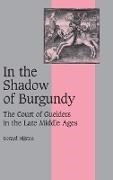Read more
Informationen zum Autor Gerard Nijsten teaches history at the Vrije Universiteit, Amsterdam. Klappentext This wide-ranging study of the court of Guelders in the Low Countries provides an excellent vantage point for the study of late medieval court culture. Despite being surrounded by the vast territories of the dukes of Burgundy! and the growing power of the Valois dukes! the court managed to remain independent until 1473. Archival sources convey the striking cultural and political richness of the court! poised between French and German spheres of influence! and demonstrate how Guelders can be considered as representative of Europe's many medium-sized courts. Zusammenfassung This book offers a wide-ranging study of the court of Guelders in the Low Countries! offering an excellent vantage point for the study of late medieval court culture. Poised between French and German spheres of influence! it shows how Guelders can be taken as representative of Europe's many medium-sized courts. Inhaltsverzeichnis Foreword; Brief chronology of the history of the counts and dukes of Guelders; Introduction; Part I. Court: 1. The social framework: functions and functionaries; 2. A medium-sized court on its travels; 3. Finances at the court: in search of money; 4. The ideal prince; Part II. The Arts: 5. Music and musicians; 6. Literature: the written and the spoken word; 7. Books: readers, writers and illuminators; 8. Visual and applied arts; Part III. Court Culture: 9. Construction and consolidation: the duke and his court; 10. Construction and consolidation: the dukes and the wider context; 11. Court culture and the forming of a 'territorial' consciousness; Appendix: Reconstruction of the book collection of Duke Arnold and Duchess Catherine; Sources and bibliography.

